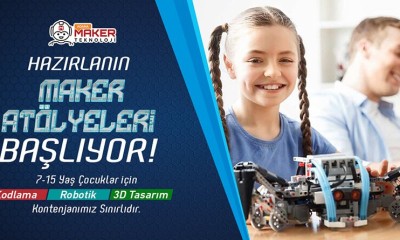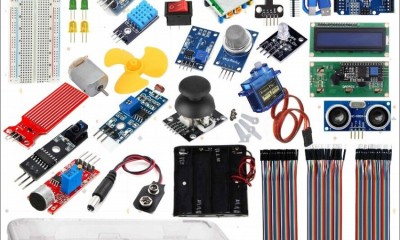 Adanada Robotik Kodlama Eğitimi Veren YerlerGeleceğin mühendislerini yetiştiriyoruz. Adana robotik kodlama atölyesi olarak bu eğitimlerde katılımcıların Robotik dünyası ile tanışmalarını, her yaş grubuna uygun...DEVAMI
Adanada Robotik Kodlama Eğitimi Veren YerlerGeleceğin mühendislerini yetiştiriyoruz. Adana robotik kodlama atölyesi olarak bu eğitimlerde katılımcıların Robotik dünyası ile tanışmalarını, her yaş grubuna uygun...DEVAMIARDUİNO İLE LABİRENT ÇÖZEN ROBOT YAPIMI
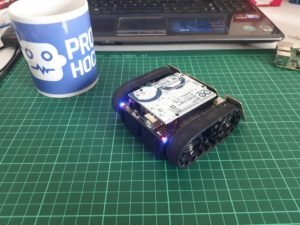
Çizgi labirent çözen zumo robot kiti yapımından bahsedeceğiz , pololu firması tarafından geliştirilip üretilen zumo robot kiti ve zumo shield ile birçok robot projesi yapabilmektesiniz.Bu yazımızda labirent çözen yapımını göstereceğiz.
Zumo robot kitini aldığınızda kit içerisinden kurulum kılavuzu çıkmaktadır kılavuza göre kurulumu gerçekleştirebilirsiniz. Kit ile beraber DC motor göndermiyorlar siz redüktörlü mikro dc motor almanız gerekmektedir.
Malzeme Listesi
- Zumo Robot Kiti
- Redüktörlü mikro dc motor
- Zumo Shield
- Zumo QTR Çizgi Sensörü
- Arduino UNO
Aşağıda zumo robotun parçaları mevcuttur.
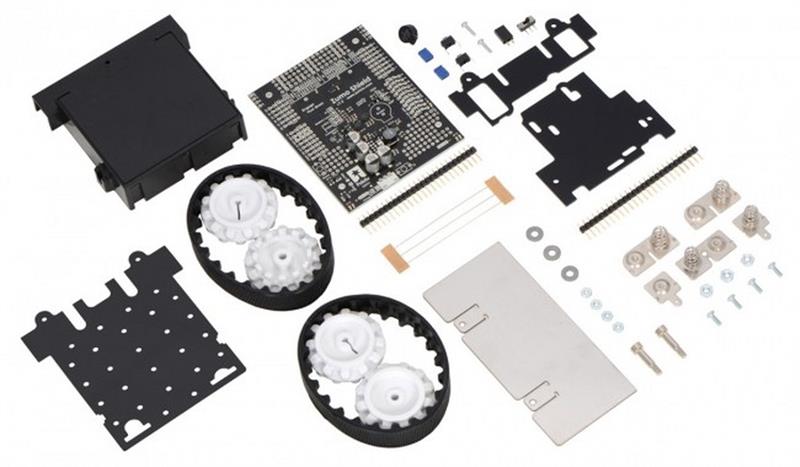 Projenin çalışma videosu
Projenin çalışma videosu
Robotu kurduğunuzda aşağıdaki gibi görünmektedir. Zumo shiled tamamen demonte halde gönderiliyor evinizde lehim yapmak için ekipmanınızın olması gerekiyor.Aksi halde robotu kurmazsınız.
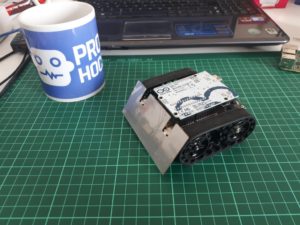
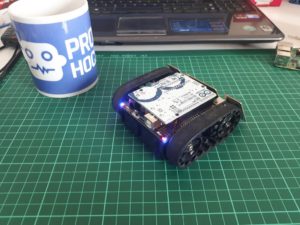
Proje için gerekli arduino kütüphanesi linki : https://github.com/pololu/zumo-shield
Projenin kodları:
#include#include#include#include#include/* This example uses the Zumo Reflectance Sensor Array* to navigate a black line maze with no loops. This program* is based off the 3pi maze solving example which can be* found here:** http://www.pololu.com/docs/0J21/8.a** The Zumo first calibrates the sensors to account* for differences of the black line on white background.* Calibration is accomplished in setup().** In loop(), the function solveMaze() is called and navigates* the Zumo until it finds the finish line which is defined as* a large black area that is thick and wide enough to* cover all six sensors at the same time.** Once the Zumo reaches the finishing line, it will stop and* wait for the user to place the Zumo back at the starting* line. The Zumo can then follow the shortest path to the finish* line.** The macros SPEED, TURN_SPEED, ABOVE_LINE(), and LINE_THICKNESS* might need to be adjusted on a case by case basis to give better* line following results.*/// SENSOR_THRESHOLD is a value to compare reflectance sensor// readings to to decide if the sensor is over a black line#define SENSOR_THRESHOLD 300// ABOVE_LINE is a helper macro that takes returns// 1 if the sensor is over the line and 0 if otherwise#define ABOVE_LINE(sensor)((sensor) > SENSOR_THRESHOLD)// Motor speed when turning. TURN_SPEED should always// have a positive value, otherwise the Zumo will turn// in the wrong direction.#define TURN_SPEED 200// Motor speed when driving straight. SPEED should always// have a positive value, otherwise the Zumo will travel in the// wrong direction.#define SPEED 200// Thickness of your line in inches#define LINE_THICKNESS .75// When the motor speed of the zumo is set by// motors.setSpeeds(200,200), 200 is in ZUNITs/Second.// A ZUNIT is a fictitious measurement of distance// and only helps to approximate how far the Zumo has// traveled. Experimentally it was observed that for// every inch, there were approximately 17142 ZUNITs.// This value will differ depending on setup/battery// life and may be adjusted accordingly. This value// was found using a 75:1 HP Motors with batteries// partially discharged.#define INCHES_TO_ZUNITS 17142.0// When the Zumo reaches the end of a segment it needs// to find out three things: if it has reached the finish line,// if there is a straight segment ahead of it, and which// segment to take. OVERSHOOT tells the Zumo how far it needs// to overshoot the segment to find out any of these things.#define OVERSHOOT(line_thickness)(((INCHES_TO_ZUNITS * (line_thickness)) / SPEED))ZumoBuzzer buzzer;ZumoReflectanceSensorArray reflectanceSensors;ZumoMotors motors;Pushbutton button(ZUMO_BUTTON);// path[] keeps a log of all the turns made// since starting the mazecharpath[100] ="";unsignedcharpath_length = 0;// the length of the pathvoidsetup(){unsignedintsensors[6];unsignedshortcount = 0;unsignedshortlast_status = 0;intturn_direction = 1;buzzer.play(">g32>>c32");reflectanceSensors.init();delay(500);pinMode(13, OUTPUT);digitalWrite(13, HIGH);// turn on LED to indicate we are in calibration modebutton.waitForButton();// Calibrate the Zumo by sweeping it from left to rightfor(inti = 0; i < 4; i ++){// Zumo will turn clockwise if turn_direction = 1.// If turn_direction = -1 Zumo will turn counter-clockwise.turn_direction *= -1;// Turn direction.motors.setSpeeds(turn_direction * TURN_SPEED, -1*turn_direction * TURN_SPEED);// This while loop monitors line position// until the turn is complete.while(count < 2){reflectanceSensors.calibrate();reflectanceSensors.readLine(sensors);if(turn_direction < 0) {// If the right most sensor changes from (over white space -> over// line or over line -> over white space) add 1 to count.count += ABOVE_LINE(sensors[5]) ^ last_status;last_status = ABOVE_LINE(sensors[5]);}else{// If the left most sensor changes from (over white space -> over// line or over line -> over white space) add 1 to count.count += ABOVE_LINE(sensors[0]) ^ last_status;last_status = ABOVE_LINE(sensors[0]);}}count = 0;last_status = 0;}// Turn left.turn('L');motors.setSpeeds(0, 0);// Sound off buzzer to denote Zumo is finished calibratingbuzzer.play("L16 cdegreg4");// Turn off LED to indicate we are through with calibrationdigitalWrite(13, LOW);}voidloop(){// solveMaze() explores every segment// of the maze until it finds the finish// line.solveMaze();// Sound off buzzer to denote Zumo has solved the mazebuzzer.play(">>a32");// The maze has been solved. When the user// places the Zumo at the starting line// and pushes the Zumo button, the Zumo// knows where the finish line is and// will automatically navigate.while(1){button.waitForButton();goToFinishLine();// Sound off buzzer to denote Zumo is at the finish line.buzzer.play(">>a32");}}// Turns according to the parameter dir, which should be// 'L' (left), 'R' (right), 'S' (straight), or 'B' (back).voidturn(chardir){// count and last_status help// keep track of how much further// the Zumo needs to turn.unsignedshortcount = 0;unsignedshortlast_status = 0;unsignedintsensors[6];// dir tests for which direction to turnswitch(dir){// Since we're using the sensors to coordinate turns instead of timing them,// we can treat a left turn the same as a direction reversal: they differ only// in whether the zumo will turn 90 degrees or 180 degrees before seeing the// line under the sensor. If 'B' is passed to the turn function when there is a// left turn available, then the Zumo will turn onto the left segment.case'L':case'B':// Turn left.motors.setSpeeds(-TURN_SPEED, TURN_SPEED);// This while loop monitors line position// until the turn is complete.while(count < 2) { reflectanceSensors.readLine(sensors);// Increment count whenever the state of the sensor changes // (white->black and black->white) since the sensor should// pass over 1 line while the robot is turning, the final// count should be 2count += ABOVE_LINE(sensors[1]) ^ last_status;last_status = ABOVE_LINE(sensors[1]);}break;case'R':// Turn right.motors.setSpeeds(TURN_SPEED, -TURN_SPEED);// This while loop monitors line position// until the turn is complete.while(count < 2) { reflectanceSensors.readLine(sensors); count += ABOVE_LINE(sensors[4]) ^ last_status; last_status = ABOVE_LINE(sensors[4]); }break;case'S':// Don't do anything! break; } } // This function decides which way to turn during the learning phase of // maze solving. It uses the variables found_left, found_straight, and // found_right, which indicate whether there is an exit in each of the // three directions, applying the "left hand on the wall" strategy. char selectTurn(unsigned char found_left, unsigned char found_straight, unsigned char found_right) { // Make a decision about how to turn. The following code // implements a left-hand-on-the-wall strategy, where we always // turn as far to the left as possible. if(found_left) return 'L'; else if(found_straight) return 'S'; else if(found_right) return 'R'; else return 'B'; } // The maze is broken down into segments. Once the Zumo decides // which segment to turn on, it will navigate until it finds another // intersection. followSegment() will then return after the // intersection is found. void followSegment() { unsigned int position; unsigned int sensors[6]; int offset_from_center; int power_difference; while(1) { // Get the position of the line. position = reflectanceSensors.readLine(sensors); // The offset_from_center should be 0 when we are on the line. offset_from_center = ((int)position) - 2500; // Compute the difference between the two motor power settings, // m1 - m2. If this is a positive number the robot will turn // to the left. If it is a negative number, the robot will // turn to the right, and the magnitude of the number determines // the sharpness of the turn. power_difference = offset_from_center / 3; // Compute the actual motor settings. We never set either motor // to a negative value. if(power_difference > SPEED)power_difference = SPEED;if(power_difference < -SPEED)power_difference = -SPEED;if(power_difference < 0)motors.setSpeeds(SPEED + power_difference, SPEED);elsemotors.setSpeeds(SPEED, SPEED - power_difference);// We use the inner four sensors (1, 2, 3, and 4) for// determining whether there is a line straight ahead, and the// sensors 0 and 5 for detecting lines going to the left and// right.if(!ABOVE_LINE(sensors[0]) && !ABOVE_LINE(sensors[1]) && !ABOVE_LINE(sensors[2]) && !ABOVE_LINE(sensors[3]) && !ABOVE_LINE(sensors[4]) && !ABOVE_LINE(sensors[5])){// There is no line visible ahead, and we didn't see any// intersection. Must be a dead end.return;}elseif(ABOVE_LINE(sensors[0]) || ABOVE_LINE(sensors[5])){// Found an intersection.return;}}}// The solveMaze() function works by applying a "left hand on the wall" strategy:// the robot follows a segment until it reaches an intersection, where it takes the// leftmost fork available to it. It records each turn it makes, and as long as the// maze has no loops, this strategy will eventually lead it to the finish. Afterwards,// the recorded path is simplified by removing dead ends. More information can be// found in the 3pi maze solving example.voidsolveMaze(){while(1){// Navigate current line segmentfollowSegment();// These variables record whether the robot has seen a line to the// left, straight ahead, and right, while examining the current// intersection.unsignedcharfound_left = 0;unsignedcharfound_straight = 0;unsignedcharfound_right = 0;// Now read the sensors and check the intersection type.unsignedintsensors[6];reflectanceSensors.readLine(sensors);// Check for left and right exits.if(ABOVE_LINE(sensors[0]))found_left = 1;if(ABOVE_LINE(sensors[5]))found_right = 1;// Drive straight a bit more, until we are// approximately in the middle of intersection.// This should help us better detect if we// have left or right segments.motors.setSpeeds(SPEED, SPEED);delay(OVERSHOOT(LINE_THICKNESS)/2);reflectanceSensors.readLine(sensors);// Check for left and right exits.if(ABOVE_LINE(sensors[0]))found_left = 1;if(ABOVE_LINE(sensors[5]))found_right = 1;// After driving a little further, we// should have passed the intersection// and can check to see if we've hit the// finish line or if there is a straight segment// ahead.delay(OVERSHOOT(LINE_THICKNESS)/2);// Check for a straight exit.reflectanceSensors.readLine(sensors);// Check again to see if left or right segment has been foundif(ABOVE_LINE(sensors[0]))found_left = 1;if(ABOVE_LINE(sensors[5]))found_right = 1;if(ABOVE_LINE(sensors[1]) || ABOVE_LINE(sensors[2]) || ABOVE_LINE(sensors[3]) || ABOVE_LINE(sensors[4]))found_straight = 1;// Check for the ending spot.// If all four middle sensors are on dark black, we have// solved the maze.if(ABOVE_LINE(sensors[1]) && ABOVE_LINE(sensors[2]) && ABOVE_LINE(sensors[3]) && ABOVE_LINE(sensors[4])){motors.setSpeeds(0,0);break;}// Intersection identification is complete.unsignedchardir = selectTurn(found_left, found_straight, found_right);// Make the turn indicated by the path.turn(dir);// Store the intersection in the path variable.path[path_length] = dir;path_length++;// You should check to make sure that the path_length does not// exceed the bounds of the array. We'll ignore that in this// example.// Simplify the learned path.simplifyPath();}}// Now enter an infinite loop - we can re-run the maze as many// times as we want to.voidgoToFinishLine(){unsignedintsensors[6];inti = 0;// Turn around if the Zumo is facing the wrong direction.if(path[0] =='B'){turn('B');i++;}for(;i{followSegment();// Drive through the intersection.motors.setSpeeds(SPEED, SPEED);delay(OVERSHOOT(LINE_THICKNESS));// Make a turn according to the instruction stored in// path[i].turn(path[i]);}// Follow the last segment up to the finish.followSegment();// The finish line has been reached.// Return and wait for another button push to// restart the maze.reflectanceSensors.readLine(sensors);motors.setSpeeds(0,0);return;}// simplifyPath analyzes the path[] array and reduces all the// turns. For example: Right turn + Right turn = (1) Back turn.voidsimplifyPath(){// only simplify the path if the second-to-last turn was a 'B'if(path_length < 3 || path[path_length - 2] !='B')return;inttotal_angle = 0;inti;for(i = 1; i <= 3; i++){switch(path[path_length - i]){case'R':total_angle += 90;break;case'L':total_angle += 270;break;case'B':total_angle += 180;break;}}// Get the angle as a number between 0 and 360 degrees.total_angle = total_angle % 360;// Replace all of those turns with a single one.switch(total_angle){case0:path[path_length - 3] ='S';break;case90:path[path_length - 3] ='R';break;case180:path[path_length - 3] ='B';break;case270:path[path_length - 3] ='L';break;}// The path is now two steps shorter.path_length -= 2;}
14.11.2018
 Adanada Robotik Kodlama Eğitimi Veren YerlerGeleceğin mühendislerini yetiştiriyoruz. Adana robotik kodlama atölyesi olarak bu eğitimlerde katılımcıların Robotik dünyası ile tanışmalarını, her yaş grubuna uygun...DEVAMI
Adanada Robotik Kodlama Eğitimi Veren YerlerGeleceğin mühendislerini yetiştiriyoruz. Adana robotik kodlama atölyesi olarak bu eğitimlerde katılımcıların Robotik dünyası ile tanışmalarını, her yaş grubuna uygun...DEVAMI Adana Robotik ve Kodlama Eğitmenlik EğitimiAdana Robotik ve Kodlama Eğitmenlik Eğitimi
Adana Maker Eğitmen Eğitimi Sertifika Programı Ekim 2021 ayında ÇUBİTED ve MAG-NET WEB işbirliği ile yapılacak...DEVAMI
Adana Robotik ve Kodlama Eğitmenlik EğitimiAdana Robotik ve Kodlama Eğitmenlik Eğitimi
Adana Maker Eğitmen Eğitimi Sertifika Programı Ekim 2021 ayında ÇUBİTED ve MAG-NET WEB işbirliği ile yapılacak...DEVAMI